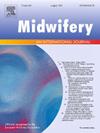妇女在水中分娩的经验:叙述综合的系统回顾
IF 2.6
3区 医学
Q1 NURSING
引用次数: 0
摘要
分娩是女性一生中的一件大事,受多种因素的影响,包括个人环境、分娩过程、提供的护理、社会支持和分娩后的直接经历。尽管近年来水中分娩越来越流行,但对女性经验的研究仍然有限。本综述旨在综合有关妇女水中分娩经验的证据,为临床指南提供依据,支持个性化护理,并确定未来研究的重点。方法本研究是一项系统综述,检索了三个数据库(CINAHL, Scopus和PubMed),涵盖2013年至2023年。共有17项研究符合纳入标准,通过叙事综合方法对数据进行分析。研究结果确定了八个类别,这些类别反映了妇女在水中分娩的经历。在水中分娩的女性通常会有一种强烈的控制感,将这种体验描述为赋予权力、亲密和放松。她们很看重在分娩池中变换体位的便利性,尽管有些人觉得泳池的设计很有挑战性,有时还会让人不舒服。总的来说,水被广泛认为是一种有效的缓解疼痛的方法,也是一种自然的、积极的分娩选择,尽管它也会引起负面情绪。伴侣和助产士的作用都是至关重要的,妇女通常报告在水中分娩后的积极经历。结论多数产妇对水中分娩满意。然而,需要进一步的研究来了解水中分娩对妇女心理健康的影响,以及伴侣和助产士的观点。此外,需要进一步探索文化观念和提供全面信息以支持准妈妈决策的有效方法。本文章由计算机程序翻译,如有差异,请以英文原文为准。
Women’s experiences of waterbirth: A systematic review with narrative synthesis
Background
Childbirth is a major event in a woman's life, shaped by various factors including the individual's circumstances, the birth process, the care provided, social support, and immediate post-birth experiences. Although waterbirth has become increasingly popular in recent years, research on women’s experience remains limited. This review aims to synthesize evidence on women’s experiences of waterbirths to inform clinical guidelines, support personalized care, and identify priorities for future research.
Methods
This study was a systematic review, with searches conducted across three databases (CINAHL, Scopus, and PubMed) covering 2013 to 2023. A total of 17 studies met the inclusion criteria, and the data were analyzed through a narrative synthesis approach.
Findings
Eight categories were identified that capture women's experiences with waterbirth. Women who give birth in water often feel a strong sense of control, describing the experience as empowering, intimate, and relaxing. They value the ease of changing positions in the birthing pool, although some find the pool’s design challenging and occasionally uncomfortable. Overall, water is widely regarded as an effective pain relief method and a natural, positive childbirth option, though it can also evoke negative emotions. The roles of both the partner and midwife are essential, and women generally report positive experiences following a waterbirth.
Conclusion
Most women were satisfied with waterbirth. However, further research is needed to understand waterbirth’s impact on women's psychological well-being, as well as the perspectives of partners and midwives. Additionally, cultural perceptions and effective ways to provide comprehensive information to support expectant mothers in their decision-making require further exploration.
求助全文
通过发布文献求助,成功后即可免费获取论文全文。
去求助
来源期刊

Midwifery
医学-护理
CiteScore
4.50
自引率
7.40%
发文量
221
审稿时长
13.4 weeks
期刊介绍:
Midwifery publishes the latest peer reviewed international research to inform the safety, quality, outcomes and experiences of pregnancy, birth and maternity care for childbearing women, their babies and families. The journal’s publications support midwives and maternity care providers to explore and develop their knowledge, skills and attitudes informed by best available evidence.
Midwifery provides an international, interdisciplinary forum for the publication, dissemination and discussion of advances in evidence, controversies and current research, and promotes continuing education through publication of systematic and other scholarly reviews and updates. Midwifery articles cover the cultural, clinical, psycho-social, sociological, epidemiological, education, managerial, workforce, organizational and technological areas of practice in preconception, maternal and infant care.
The journal welcomes the highest quality scholarly research that employs rigorous methodology. Midwifery is a leading international journal in midwifery and maternal health with a current impact factor of 1.861 (© Thomson Reuters Journal Citation Reports 2016) and employs a double-blind peer review process.
 求助内容:
求助内容: 应助结果提醒方式:
应助结果提醒方式:


